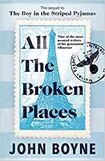
John Boyne likes to quote the Kingsley Amis line: “If you can’t annoy somebody, there is little point in writing.” With 21 books to his name, Boyne’s work has succeeded in annoying multiple communities, including Holocaust educators. In 2020, he engaged in a Twitter spat with the Auschwitz-Birkenau Memorial and Museum about his 2006 best-selling YA novel, The Boy in the Striped Pyjamas. Ironically, he brought the attention upon himself: in the wake of the success of Heather Morris’s The Tattooist of Auschwitz – the best-selling book in Ireland in 2018 and 2019 – Boyne tweeted his irritation about the flurry of books with Auschwitz in the title. The subject matter, he wrote, “should be treated with a little more thought and consideration”.
While over a third of English secondary schools use The Boy in the Striped Pyjamas and its film adaptation in Holocaust lessons, Auschwitz Memorial replied that the book “should be avoided by anyone who studies or teaches about the Holocaust”. The tweet linked to a 2019 essay in which Hannah May Randall, the head of learning at Holocaust Centre North, highlights the novel’s historical inaccuracies and faults it for perpetuating “dangerous myths”.
Boyne has defended The Boy in the Striped Pyjamas by pointing to its subtitle, “A Fable”, and his efforts to educate children that the book is a novel. Fiction should not bear the burden of education, he argues. Nonetheless, a survey by the London Jewish Cultural Centre found that 75 per cent of respondents thought that it had been based on a true story.
A sequel of sorts, All the Broken Places follows the story of Gretel, the now 91-year-old sister of Bruno, the protagonist of The Boy in the Striped Pyjamas. The book toggles between Gretel’s present-day life in London and various points in her past: Paris and Rouen, where she escapes with her mother after the war; Sydney in 1950; and London in 1953 and 1970. Gretel grapples with the guilt of the crimes perpetrated by her father, a Nazi commandant of Auschwitz, and what she believes was her inadvertent implication in Bruno’s death.
Conclave: Ralph Fiennes is flawless in Robert Harris’s preposterously gripping drama of papal electioneering
First Look: The Rooftop Bar cocktail and dining area at The Marker – the place to be when the sun sets
The Last of Us drops a bombshell for the TV ages. Did that really just happen?
Let’s put a real kitchen in every school. We could use some of the Apple taxes
Under an assumed name, Gretel tries to reinvent herself, but is haunted by her past wherever she goes. We witness her being violently humiliated in France and fatefully crossing paths with a childhood love interest – a Nazi soldier – in Australia, causing her to flee to London. Before she starts dating the man who becomes her husband, she dates his Jewish friend, who lost his family in Treblinka. When she confesses her identity, he tells her to burn in hell and takes off to America. Gretel has a breakdown when her son is nine, the age at which her brother died. She spends a year in a psychiatric ward without confessing the source of her trauma to a doctor.
Now widowed, Gretel keeps mostly to herself in her Mayfair apartment to avoid detection, save for a friend in the building and occasional visits from her bumbling son. The plot revolves around a family with a nine-year-old boy moving in downstairs. When Gretel witnesses abuse by the father, who digs into her past – effectively as blackmail – she must decide whether to risk having her identity revealed if she reports him.
The story of The Boy in the Striped Pyjamas, in which Bruno befriends Shmuel, a boy imprisoned at Auschwitz, is incorporated in All the Broken Places in flashback. The historical inaccuracies, as such, persist: children who arrived in Auschwitz were in fact immediately gassed, barring a few used for medical experimentation who were not kept in the main camp.
Boyne takes the opportunity to tweak a few details to appease the criticism: a flashback of Gretel meeting Shmuel has him saying that “there aren’t many” children in the camp, explaining that he has been saved because his fingers were small enough to clean bullet shells. (In The Boy in the Striped Pyjamas, Shmuel had said there were “hundreds [of children] probably”. Still, the premise that Bruno could have been unaware of what was happening at Auschwitz is impossible.
“For all the mistakes in her life, for all her complicity in evil, and for all her regrets, I believe that Gretel’s story is also worth telling,” Boyne writes in an author’s note. “It is up to the reader to decide whether it is worth reading.” For this reader, alas, the answer is no. Whether our sympathies lie with Gretel’s first-person account is moot because the characters are too thinly drawn to evoke emotion either way. Other shortcomings include clunky plot devices, implausible dialogue, an unnecessary twist and a preposterous ending. The problem with All the Broken Places is less whether Gretel’s story is worth telling than how it’s told.
Luckily for Boyne, commercial success is impervious to historical accuracy and the tastes of literary critics. Despite being denounced as “lurid” and “appalling” by the real-life Cilka’s stepson, Cilka’s Journey, the sequel to The Tattooist of Auschwitz, went on to sell over a million copies worldwide.
”Writing about the Holocaust is a fraught business and any novelist approaching it takes on an enormous burden of responsibility,” Boyne writes in his author’s note. “Not the burden of education, which is the task of non-fiction, but the burden of exploring emotional truths and authentic human experiences while remembering that the story of every person who died in the Holocaust is one that is worth telling.”














